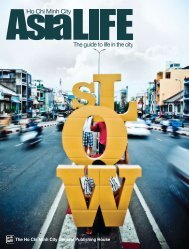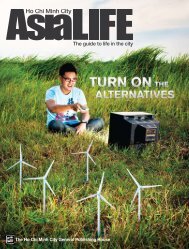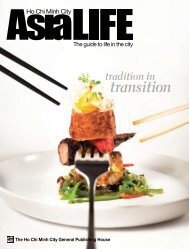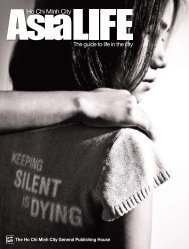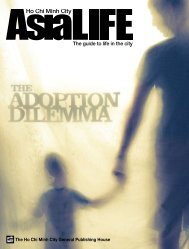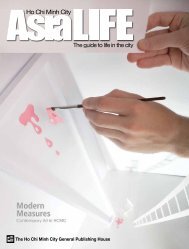Brett Davis - AsiaLIFE Magazine
Brett Davis - AsiaLIFE Magazine
Brett Davis - AsiaLIFE Magazine
You also want an ePaper? Increase the reach of your titles
YUMPU automatically turns print PDFs into web optimized ePapers that Google loves.
In the Land of<br />
Gibbons<br />
The Gibbon Experience gives adventure travellers<br />
the opportunity to live in the trees and soar<br />
through the jungle canopy of northwestern Laos.<br />
Tom DiChristopher takes to the sky on one of the<br />
conservation-oriented project’s three-day treks.<br />
Photos by Fred Wissink.<br />
The zip line is still buzzing<br />
when I grasp it to lock my trolley<br />
into place. The velocity of<br />
its last passenger reverberates<br />
through my arm and rattles my<br />
nerves. Moments ago, our guide<br />
Boonpeng led the first flight,<br />
followed enthusiastically by my<br />
girlfriend Sarah and her sister<br />
Ryann’s boyfriend, Josh. Now<br />
Ryann, a pair of British travellers<br />
and our second guide, Nuon, are<br />
waiting for me.<br />
It dawns on me that a zip line<br />
platform a few hundred metres<br />
above the jungle floor is a bad<br />
place to realize you’ve wildly<br />
underestimated your fear of<br />
heights.<br />
And this is just the start.<br />
We’ve signed on for a threeday<br />
trek and aerial adventure<br />
through northwestern Laos’<br />
Bokeo Nam Kan Nature Reserve<br />
called the Gibbon Experience.<br />
During the trip, I will not only<br />
tackle a network of zip lines,<br />
I’ll also be sleeping in a tree<br />
house. At present, however, I’m<br />
just trying to take the first step.<br />
With panic and humiliation<br />
tug-of-roping me back and forth<br />
between fight and flight, I try every<br />
trick in the book: check that<br />
my trolley’s wheels are aligned,<br />
give its rubber tyre brake a test<br />
squeeze, retighten my harness,<br />
triple-check the carabiner on my<br />
safety rope. All systems are go.<br />
I lumber forward into a foetal<br />
crouch and an instant later the<br />
harness kung-fu grips me in<br />
all the wrong places. The zip<br />
line sings in my ear as I pick up<br />
speed through the corridor of<br />
foliage breezing past. Then, the<br />
sun pours over me and warms<br />
my skin. I wrestle my eyes from<br />
the trolley and gaze out over the<br />
mountains. Light and shadow<br />
colour them into a patchwork<br />
of camouflage. Below the Nam<br />
Nga River is just a ribbon, its<br />
flow almost imperceptible. Out<br />
here in the open, with nothing to<br />
measure my speed against, time<br />
and space calcify. I feel like I’m<br />
passing through a postcard.<br />
Then, the foliage whips by<br />
once again and the screeching<br />
zip line drops a few octaves. I<br />
slow to a stop a few metres from<br />
the landing platform, turning<br />
to pull myself hand over<br />
hand. With my feet back on<br />
solid ground, I holler across the<br />
chasm. “OK!”<br />
In the Trees<br />
After tackling another series of<br />
zip lines, we try our hand at a<br />
new challenge: docking in a tree<br />
Since visitors stick to the trails, cables and<br />
trees on the outskirts of the forest, their<br />
impact on the environment is minimal.<br />
house. Boonpeng looks back and<br />
says “brake” before leaping into<br />
another of his carefree madman<br />
launches. When it’s my turn I<br />
peared briefly to arrange lunch,<br />
but soon joined in, scaling the<br />
rocks and leaping into the chilly<br />
pool. This outdoor amenity is<br />
included in the Waterfall Experience<br />
option, and while cooling<br />
our aching muscles, we were<br />
glad we’d booked it. Later we<br />
were perhaps less pleased with<br />
ourselves; the Waterfall Experience<br />
also entails considerably<br />
longer daily hikes than the Classic<br />
Experience.<br />
Our second morning, however,<br />
the troops are showing<br />
fatigue. Sleeping accommodations<br />
are sub-optimal. The<br />
mattresses are thin. In place of<br />
mosquito nets, thick sheets hang<br />
from the ceiling, leaving two<br />
options: sweat it out or contend<br />
with mosquitoes. Most of us are<br />
working on about a half night’s<br />
sleep, and now we’ve got to hike<br />
to the next tree house.<br />
With muscles sore from<br />
yesterday’s hike and too little<br />
sleep, the day’s trek is arduous.<br />
We labour up steep, swerving<br />
paths, and then jog spaghettilegged<br />
down again. The process<br />
repeats itself over and over in<br />
a cruel, Ecsher-esque cycle. My<br />
backpack digs into my shoulfollow<br />
suit with another graceless<br />
plummet, peering ahead<br />
until I see it in the distance—<br />
like a hamburger balanced on a<br />
toothpick, a gazebo-like structure<br />
suspended in the trees.<br />
“Brake! Brake! Brake!” yells<br />
Boonpeng. I heed his warning<br />
and glide into the cramped landing<br />
platform beneath the tree<br />
house. Off to the side, our bathroom<br />
occupies little more than a<br />
balcony. Up above, the space is<br />
wide open, giving us 360-degree<br />
views of the mountains and<br />
forest. There’s even a makeshift<br />
kitchen with a gas range and<br />
sink. A resident cat paroles the<br />
tree house for forest rats that<br />
might scurry across the cables.<br />
We have everything we need<br />
to indulge our Swiss Family<br />
Robinson fantasies, save coconut<br />
bombs and a cross-dressing<br />
cabin boy.<br />
While the accommodations<br />
make for a fantastical getaway,<br />
they’re also integral to the<br />
Gibbon Experience’s overall<br />
mission. The project is named<br />
after the black-crested gibbon, a<br />
highly endangered primate that<br />
occupies parts of the 123,000<br />
hectare Bokeo Nature Reserve.<br />
The gibbons’ habitat is itself<br />
under threat, as well. Travelling<br />
through Laos, the sight of mountainsides<br />
clear cut for lumber<br />
is all too common. Laos lost 6.8<br />
percent of its forest between<br />
1990 and 2005 to slash-and-burn<br />
agriculture, logging, fuel wood<br />
collection and fires, according<br />
to United Nations FAO statistics<br />
compiled by conservation website<br />
Mongabay.com.<br />
In 2003 French ecotourism<br />
company Animo planted the<br />
roots of the Gibbon Experience<br />
in a bid to conserve Bokeo’s<br />
mountainous deciduous forest<br />
and generate income for local<br />
villagers, who work as patrol<br />
guards, guides, builders and<br />
cooks. Today, it maintains six<br />
tree houses and a network of<br />
zip lines. Since visitors stick to<br />
the trails, cables and trees on<br />
the outskirts of the forest, their<br />
impact on the environment is<br />
minimal.<br />
Over the next three days,<br />
however, I would learn that lowimpact<br />
travel can come with a<br />
high-impact workout.<br />
On the Trails<br />
By many standards, the Gib-<br />
bon Experience is rugged. Our<br />
journey from the border town<br />
of Houayxay had set the tone.<br />
We crammed into the bed of<br />
a songthaew with rucksacks,<br />
rations and a rotating cast of<br />
local commuters and spent the<br />
next three hours clinging to the<br />
truck’s canopy as it pitched back<br />
and forth along dusty, cratered<br />
switchbacks. Once we reached<br />
the staging village of Baan Toup,<br />
we had only 15 minutes to size<br />
up the outgoing group—filthy<br />
and exhausted, but in good<br />
spirits—before hitting the trails.<br />
Those first hours passed<br />
quickly as we took in the sights<br />
and sounds of the jungle. Giant<br />
fan-like ferns glowed electric<br />
green in the sun. Knotted, vinewrapped<br />
tree trunks spiraled<br />
skywards. Bent and broken<br />
bamboo formed archways and<br />
scaffolding overhead. Birdcalls<br />
so absurd they seemed artificial<br />
echoed in the canopy, while the<br />
chomp chomp of termite feasts<br />
crackled underfoot.<br />
Just when exhaustion had<br />
set in, we arrived at a craggy<br />
cove along the Nam Nga River<br />
fed by a small, tiered waterfall.<br />
Boonpeng and Nuon disap-<br />
ders. The harness weighs me<br />
down. Sweat streams down my<br />
forehead. Boonpeng and Nuan<br />
regularly update us. Three more<br />
hours. Two more. One more. I’m<br />
not sure if it’s helping. It always<br />
seems like we should be closer<br />
than we are.<br />
When we finally reach the<br />
first zip line, I clip in without a<br />
thought and jump. It seems I’ve<br />
found a cure for my acrophobia:<br />
exhaustion.<br />
Among the Gibbons<br />
I had been under the impression<br />
that zip lining at night was<br />
forbidden. So I was more than a<br />
little surprised when Boonpeng<br />
informed us yesterday evening<br />
that we’d be zipping out at 4 am.<br />
The gibbons get up early, you<br />
know.<br />
We’re running behind, staggering<br />
around by flashlight<br />
when we hear it: a loud crack<br />
in the distance. Boonpeng suddenly<br />
looks uncomfortable.<br />
“Poachers?” I ask. “Hunters?”<br />
“Yes,” he says. “Or rangers.”<br />
No matter. The shots are<br />
far off and a more frightening<br />
prospect is at hand. We’ve got<br />
to launch into pitch black nothingness<br />
from what everyone<br />
has agreed is the most unnerving<br />
platform, literally a plank<br />
suspended about half a metre<br />
from the edge of the tree house.<br />
Josh and I are last out, and he<br />
graciously let’s me go first. I step<br />
out on the plank and shimmy<br />
into sitting position. “If I fall,” I<br />
tell him, “at least it’s too dark to<br />
see where I’m falling.” And then<br />
I’m gone, praying that the zip<br />
line’s song will rise and fall as<br />
it should. Up ahead, something<br />
glimmers. Boonpeng and Nuan<br />
have lined either side of the<br />
landing platform with candles,<br />
turning it into a backwoods<br />
tarmac.<br />
Hours later, we arrive at the<br />
tree house. The residents—an<br />
older couple and their grandson—wake<br />
up and we introduce<br />
ourselves awkwardly, like squatters.<br />
Over breakfast, we compare<br />
our travails. And then, somewhere<br />
out in the trees, the first<br />
calls drift across the expanse:<br />
More gibbons join in, and soon the clarion<br />
becomes a chorus, the calls overlapping<br />
from all sides.<br />
Whoooooop! Whoop! Whoop!<br />
Whoop! More gibbons join in,<br />
and soon the clarion becomes<br />
a chorus, the calls overlapping<br />
from all sides.<br />
A reverent, church-like silence<br />
falls on the tree house. The<br />
morning is cool, and the fog rolls<br />
off the valleys, hovering among<br />
the hilltops. Everyone gazes out,<br />
looking for signs of the elusive<br />
gibbons. They never come into<br />
sight, but when we get back on<br />
the trail to Baan Toup, their calls<br />
still lilt through the air like a<br />
farewell as we prepare to return<br />
to civilization.<br />
The Classic and Waterfall Experiences<br />
are €180 (USD $231) for<br />
group accommodation, inclusive of<br />
meals and snacks. The more private<br />
Spa Experience is €250 (USD<br />
$321) and includes massage. For<br />
more information, visit gibbonexperience.org.<br />
38 asialife HCMC asialife HCMC 39



